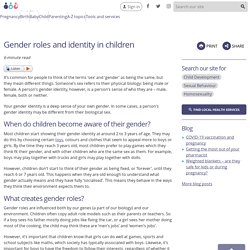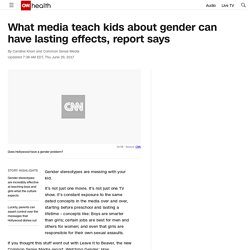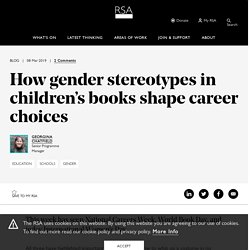

Gender Roles. Range of Gender Identities. Gender Roles and Identity in Children. It’s common for people to think of the terms ‘sex’ and ‘gender’ as being the same, but they mean different things.

Someone’s sex refers to their physical biology: being male or female. A person’s gender identity, however, is a person’s sense of who they are – male, female, both or neither. Your gender identity is a deep sense of your own gender. In some cases, a person’s gender identity may be different from their biological sex. What it being a boy or girl means to kids around the world, and how gender affects their lives. Boys and Girls on Stereotypes. According to Social Learning Theory... Introduction to Social Learning Theory and Gender Development. Social Learning Theory states that individuals develop gender by imitating role models.

SLT states that observational learning takes place, and that this learning is reinforced vicariously. Vicarious reinforcement occurs when a person witnesses a model being rewarded for behaving in a gender-appropriate way (e.g. a girl being praised for playing quietly with her dolls). Vicarious reinforcement makes it more likely that the model’s behaviour will be imitated in the future. [From 4:08] Social Learning Theories of Gender Role Formation. Through Differential Reinforcement... More About Differential Reinforcement. Differential reinforcement is a strategy used in applied behavior analysis (ABA) to address challenging or undesirable behavior, usually in children.

While there are a number of techniques used in differential reinforcement, the goal is always the same: to encourage appropriate behavior by giving or withholding reinforcement. The theory behind differential reinforcement is that people tend to repeat behaviors that are reinforced or rewarded and are less likely to continue behaviors that aren’t reinforced. Differential reinforcement consists of two components: Reinforcing the appropriate behaviorWithholding reinforcement of the inappropriate behavior ‘Appropriate’ behavior in differential reinforcement may be recognized as: (1) not behaving inappropriately; or (2) choosing a positive response over a negative one. Reinforcement and Punishment in Gender Related Behavior. What media teach kids about gender can have lasting effects. Story highlights Gender stereotypes are incredibly effective at teaching boys and girls what the culture expects Luckily, parents can assert control over the messages that Hollywood dishes out.

How stereotypes in TV shows and movies may impact your child's development. Must monsters always be male? Huge gender bias revealed in children’s books. Male characters are twice as likely to take leading roles in children’s picture books and are given far more speaking parts than females, according to Observer research that shines a spotlight on the casual sexism apparently inherent in young children’s reading material.

In-depth analysis of the 100 most popular children’s picture books of 2017, carried out by this paper with market research company Nielsen, reveals the majority are dominated by male characters, often in stereotypically masculine roles, while female characters are missing from a fifth of the books ranked. The 2017 bestseller list includes perennial favourites The Gruffalo, Guess How Much I Love You and Dear Zoo, in which all the animals are referred to by a male pronoun, as if by default.
The lead characters were 50% more likely to be male than female, and male villains were eight times more likely to appear compared to female villains. “Authors and illustrators have fantastic opportunities to break down stereotypes. How Gender Stereotypes in Children’s Books Shape Career Choices. This week has seen National Careers Week, World Book Day, and today International Women’s Day.

All three have highlighted important issues (not least how to whip up a costume in no time). But in the middle of these three issues is a ‘sweet spot’: the representation of gender in children’s books and how this might affect the types of careers that young people are aware of and aspire to be in. How careers aspirations are shaped by characters Those of us responsible for children have choices about how they are invited to investigate and discover the world around them. From the very beginning you are led down the well-trodden, pre-determined routes that boys are exposed to blue, dinosaurs, transport, animals, and rockets, while girls can expect, pink, princesses, fairies, unicorns, and ponies. Start by understanding gender roles. Understanding Gender Roles Have you ever really considered why the toy aisles at your favorite department store are divided into “boys” and “girls” sections?

What makes a toy a “boys” or a “girls” toy? Don't dictate gender roles on your children. Have conversations with your children. Avoid preconceived notions. Think again: Are you giving your child the opportunity to be whoever they are?